#women in commercial real estate
Explore tagged Tumblr posts
Text
BL doujin & Men Who Make Some of Them
If BL is stories of androphilic men by androphilic women, then what’s the opposite of that? It would probably be stories of androphilic women by androphilic men.
The latter is what Minamoto Kazuki mainly dabbles in.

Apart from straight & BL manga, he also authored Shoujo Manga Artist Minamoto-San Comes Out. Yeah, that’s the title. It is autobiographical if that wasn���t obvious. Arguably, his most famous manga, at least in BL fandom, is Wall Circle's Doujin Artist Nekoyashiki-Kun's Desire for Recognition Grows which got live-action adaptation: KabeKoji in 2022.
Androphilic male characters who create straight content is not rare in BL. In 2023, from what I can recall, we got two such characters: Sung Woo Jae from Individual Circumstances (2023) and Yoh from Taikan Yoho (2023). Jinta from Cherry Magic (2023) also writes (presumably straight) romance. Even before that, we got an entire BL live-action franchise (starting with The Novelist (2018)).
Doujin production and consumption
Doujinshi (doujin for short) is self-published works. It includes both derivative works (fan works) as well as original works. It is estimated that nearly half of the doujin produced and circulated are BL. These are traditionally sold at conventions like Comiket. These days doujin are sold online, for example through dedicated websites like DL site.
Doujinshi culture and Comiket especially has been instrumental in the development of BL as a genre. Unfortunately, unlike other BL pioneers such as Mari Mori (her 1961 novel A Lovers' Forest is considered the first BL) and the Year 24 Group, Meikyu doujin circle (Yoshihiro Yonezawa in particular) seldom find mention in history of BL.
BL doujin grew side by side with commercially published works. The original use of the portmanteau yaoi (no peak, no fall, no meaning) was an indication of plot what plot nature of those doujins that subverted the East Asian narrative structure to focuse exclusively on erotic relations. Doujin BL varied widely in themes and approaches, even more than commercial BL as doujin are not created to appeal to the masses, instead cater to super-specific fandoms. Also, it is easier to debut into doujin arena than to commercial BL. However, since these are literally ‘thin books’ in most cases, there is associated limitation. There is cost of printing to be taken into account as well.
As more explicit doujin (yaoi) and less explicit BL (shonen ai, etc.) coevolved in a porous environment, BL transformed into a successful genre in itself with numerous dedicated magazines and multimedia adaptations. Moreover, doujin was good ground for experimentation and yields in that arena made its way into mainstream BL and enriched it.
Commercial BL welcomed many doujinshika into its fold. e.g. Ayano Yamane (author of the Finder series) is associated with a bunch of doujin circles at different points in time: GUN MANIA, Shouhoku Taiiku Yougushitsu and Ouka Seisaku.
BL mangaka continued producing both doujin and commercial BL. e.g. Kizu Natsuki (author of Given) is a prolific doujinshika under the name Gusari in Sashikizu circle.
BL mangaka produced doujin of their own work. e.g. Ichikawa Kei (author of Blue Sky Complex) published erotic extras as doujin.
These days, there is pixiv among others and long serialization possibilities. Authors are less constrained by space – unlike physical publication, web publication is not constrained by real estate (number of pages, chapters, etc.). Thanks to the internet, the distance between doujin and commercial BL have shortened.
A lot of gei comi (bara) is also self-published.
Doujin BL culture exists everywhere BL is famous with wide variation.
Doujin played an important role in emergence and growth of Korean BL. e.g. Totally Captivated by Yoo Ha Jin had doujin extras.
Chinese doujin culture is slightly different from that in other countries. Note-worthy is the self-publication of danmei (Chinese BL) novels. Three most recent cases against danmei authors [and their accomplices including those who helped the authors print, bind, package and sell those copies] were for self-publication.
天一(Tian Yi) for her student X teacher SM erotica 攻占 (Seize Control) - charged for self-publication and violation of law prohibiting publication of obscenity [explicit SM involving a 17-year-old student and his teacher in the novel]
深海先生 (Mr. Deep Sea) for her historical romance 锁帝翎 (aka 笼中帝 ; The Caged Emperor) - charged for self-publication.
There is a third. But the details are not available in the public domain.
It used to be a common practice for authors to self-publish uncensored versions of their web-published works, sometimes with explicit extras. These were intended for fans who wanted to collect these copies and to express their appreciation to the authors. Both self-publishing and “obscene content” are illegal in China.
Doujin, BL and their creators
Kabe Koji is the journey of a doujinshika, Mamoru Nekoyashiki, who yearns to be recognized as such and also as a beloved. While in high school, he fell in love with his childhood friend Kazama Issei whom he is sure doesn’t like him like that, thanks to rampant compulsory heterosexuality. Being gay was something he felt he had to keep under wraps not only because of fear of rejection but also because of heterosexism. Talented in drawing, he visits Comic King, a popular otaku convention where he discovers a different world – where male androphilia is celebrated in art.
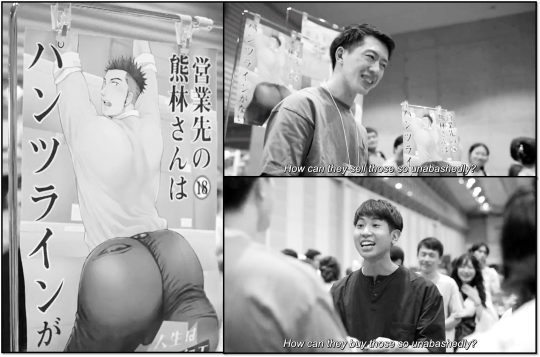
This inspires him to cultivate his talent in drawing and to pursue a career in manga. Since the art he was most drawn in by was ero-manga with macho uke with bitch characteristics, that’s the style he pursues.
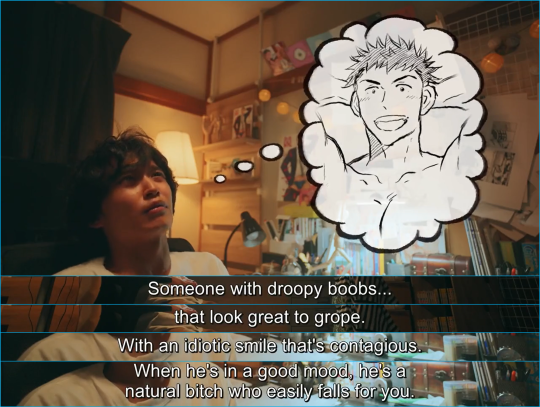
When we meet him, this is the subgenre that we see him focusing on. His influences are pretty obvious.
Moreover, the main character (hence the target of affection in his work) looks a bit like his crush. Issei notices this and tries to draw himself like that (with disproportionately thin neck) in little notes and letters to his Mamocchi.

[I honestly think Nakao Masaki was bit of a miscast for this role appearance-wise because in the manga Issei is more on the gacchiri (muscular) side of ikemen. Whoever thought Torii-san’s uke from Fudanshi Bartender no Tashinami (2022) would be right fit for Issei’s character. The actor clearly didn’t disappoint in any other aspect. This is like the case with casting decision in One Room Angel (2023) wherein a manga character with gachimuchi aesthetics was changed into a lean ikemen. An opportunity for a different body-type was wasted. No complains against those actors since they aren’t the ones responsible for casting.] This is an erroneous assessment. Thank you @tompetertrash for correcting me.
Nekoyashiki, while pursuing training and education in manga making, has already established himself as a fairly successful doujinshika known as Honeniku-sensei of Muscle Department Store. He belongs to the Wall Circle.
"Kabe circle" (wall circle) — a slang term for doujin groups or "circles" that are popular enough for their booths to be placed beside the wall of the convention, for ease of line management. (Source: ANN)
He is friends with Yamada, a fujoshi who is his support in creating, defending and selling doujin.
Such friendships are not too rare. For example, friendship between Yoh and Manju in Taikan Yoho (2023). And the IRL friendship between female danmei author Lan Lin and male manhuajia Liang Azha.
Yun SuAn's friend Choi is a BL manhwaga in My Damn Business (2024).
Nekoyashiki meets two other characters at Comic King: Framboise and Takkun.

Framboise is the president of a doujin circle called Bearded Beauties. He is very popular. He is not only among the wall circles each time we see him, but also is showered with gifts by his fans. He acknowledges that he has been doujinshika for years. His art resembles him – body-type, facial hair, moe. He keeps inviting Nekoyashiki warmly to a gathering of muscle BL artists despite getting turned down. His interactions with Nekoyashiki are precious.
Takkun is Nekoyashiki’s fan. He is inspired by Nekoyashiki and worked hard to establish himself as a wall circle doujinshika.

His rise from a consumer to producer of doujin and finally a wall circle doujinshika mirror's Nekoyashiki’s journey. Moreover, his rise is contrasted with Nekoyashiki’s fall.

Also, one of two characters on his doujin cover looks a lot like him.

Unlike Framboise and Takkun who draw what they like, Nekoyashiki draws to be recognized.

Nekoyashiki draws a second season to his previous work Please Suck on my Enormous, Manly Tits. Despite Yamada’s best hopes, it is not popular at all and loses Nekoyashiki his position as a wall circle doujinshika. He bids goodbye to Suck My Manly Tits series and to ero-manga sub-genre in general.
In a desperate attempt to climb back into popularity, he tries classic BL pairing. We get to see him reading commercial BL as a part of his research. This is an obvious mistake. Yamada wants to intervene but hesitates and ultimately gives up.
When his next doujin, My Perfect Boss Became My Perfect Spouse, also flops, he loses his resolve to be a mangaka.
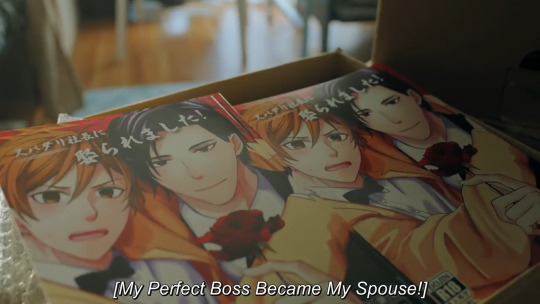
Yamada asks Nekoyashiki to be more honest and expressive in his creation.

In the end, Nekoyashiki creates a doujin inspired by his own relationship and aspirations – a work that, Framboise and Yamada notices, is to Nekoyashiki’s satisfaction.





It is common for at least some characters by male BL and gei comi mangakas (who have revealed themselves) to look at least a little bit like themselves. To see examples, check out the beginning of Massive: Gay Erotic Manga and the Men Who Make It where representative art and artists are placed side by side. Some even acknowledge this. e.g. Chinese BL manhuajia Liang Azha once commented on how his shou (uke) tend to look like him as he is today and his gong (seme) resemble his looks from his college days. Moreover, art tend to inspire clothing, haircuts, and other features which in turn inspire art. The influence Tom of Finland had on androphilic men of his days and they on him is discussed in his 2017 biopic. Similarly, mangakas are influenced by their senpais in the field and sometimes it is noticeable in their art too. e.g. Gengoroh Tagame’s historical works looks quite a bit like those of Go Mishima.
Other BL doujinshika in Live-action BL
Yoh from Taikan Yoho (2023) creates his first BL doujin, inspired by his ikemen boyfriend and their relationship, in collaboration with his mangaka friend Manju after his career as commercial mangaka of straight ero-manga takes a nose-dive.
BL Metamorphosis (2022) depicted the process of BL doujin creation in detail as the main character, Sayama Urara, embarks on that journey. Her friends offer her support, especially Ichinoi Yuki who funds the printing and binding. Sayama Urara doesn’t debut as doujinshika as she doesn’t set up her booth at the convention. However, one of the copies lands in the hand of one of her favorite authors Komeda Yu whose commercial BL work Kimi no Koto dake Miteitai was what brought Sayama Urara and Ichinoi Yuki together.
Komeda Yu on the other hand is a doujinshika turned commercial BL mangaka. She visits the convention in hopes of overcoming writer’s block and to rediscover her passion for drawing. She is motivated by the doujin that Sayama Urara created and emerges out of slump to continue with her series.
Fudanshi Bartender no Tashinami (2022) revolves around Soichiro Hibiki, a fudanshi bartender moonlighting as a BL doujinshika, who draws inspiration from his customers and fellow bar staff to fuel his passion.
Minamoto Kazuki
While narrative drives home the point that the various pieces of art we see are works of respective doujinshika characters through haircuts and body types, the fact remains that most of those are actual doujin by Minamoto Kazuki aka MELU. He belongs to the circle: GOOD BYE LIFE.

In case anyone want to read them, here are the links:

Kumabayashi at Work Has Not Underwear Line
One Million Miles: The Complete Collection
Competition Swimming Brief in Suit Man
A Midsummer Night's Beach Story: SM Assault Works 2
Suck My Manly Tits manga: 俺の雄っぱいがでっかくなっちまうくらいちゅーちゅー吸ってくれ
俺の雄っぱいがでっかくなっちまうくらいちゅーちゅー吸ってくれ2
"Suck My Manly Tits" doujin is in its 3rd season: 俺の雄っぱいがでっかくなっちまうくらいちゅーちゅー吸ってくれ3
Autobiographical pieces that didn't figure prominently:

30年以上マンガをほとんど読んだことなかった彼氏がBL沼にハマった話 (A story about how my boyfriend, who has barely read manga for over 30 years, got addicted to BL swamp.)

J庭でちいさな夢を叶えたゲイカップルの話 : Story of a gay mangaka and his boyfriend who participated in J.GARDEN, and their little dream that came true.
The cover of this doujin got live-action adaptation in one scene that one would miss if not looking closely:

Other interesting works by Minamoto Kazuki
Autobiographical: Shōjo Mangaka no Minamoto-san ga Kaminguauto Shimasu.
2. Those with English translation:
The Midnight Association for The Broken Hearted
The salaryman who has a fetish for suit gets horny.
The Gay Who Turned Kaiju
3. Essay-manga about doujin-making
夜寝てる間にBL原稿のお手伝いをしてくれる妖精さんがいた話
BL同人原稿(アナログ18禁!!)を東京から大阪の印刷所まで届けてくれた彼氏の話
4. About Kabe Koji (2022) live-action:
自分が原作の実写ドラマの大ファンになってしまったので原作者自らヲタ活をしています。
自分が原作の実写BLドラマをリアタイしたくて大阪へ行ってきました。

___
This is dedicated to @bengiyo and @liyazaki for gifs featuring Framboise. Thank you very much. While I was trying my hand at a review for One Room Angel (2023) and wanted to express my disappointment at the lean ikemen casting for Kouki’s role, I got an opportunity to use those gifs. I really wish someone would create some gifs for SHIMBASHI TUGBOAT content too.

(Especially this scene.)
For someone who is as much a fan of “tribes” as BenZi, I would not mind playing the 9Monster live-action BL bingo version.

112 notes
·
View notes
Text
🥂🍸 𝓕𝓻𝓪𝓷𝓴 𝓓𝓮𝓵𝓵𝓪 𝓻𝓸𝓬𝓬𝓪 𝔁 𝓯𝓮𝓶!𝓻𝓮𝓪𝓭𝓮𝓻 🍻🍷
It's gettin' hot in here (So hot)
So take off all your clothes (Ayy)
I am gettin' so hot (Uh, uh, uh, uh)
I wanna take my clothes off (Let it hang all out)

T/W:cussing, making out/kissing.. A lot.. Touching body parts,

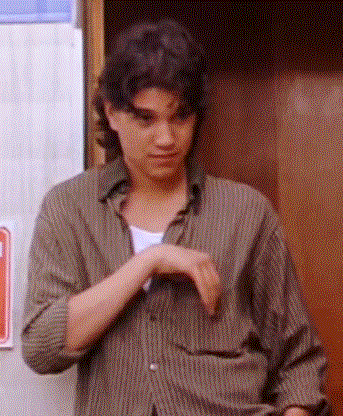

Frank saw a commercial about sexy women called easy escort and you just happen to catch his eye, so he called the number on the commercial. "Yeah, this is Frank Della rocca, the president of the reality real estate.. The young woman on the top right corner has a delicious effect on me.."
After an hour a nun came before you and when you knocked on the door and Frank looked over you through the door and then walked over to the door. "Frank Della Rocca?" You asked then Frank looked back at the other person. "Who the fuck are you?" He asked the other girl and after a few seconds of thinking the woman spoke up. "I came to buy a property."
"Oh yeah.. Reed! Reed we got a costumer!" Frank said while looking for Reed. You and the other girl stood there awkwardly until Frank got back. "Sorry, come with me.." Reed said then took the other woman to the other office and then Frank invited you inside.
"Come in." You walked into his 'office' and sat down on a table. "So.. Are we gonna do something or are we just gonna sit here?" You asked and Frank shifted his balance onto the other foot. "Its whatever you want, sweetheart."
You smiled then after a few minutes you were both in his room making out on his bed, you were both topless, you of course had a bra on but that didn't stop Frank from touching your breast. Your hands were running all over his chest.
After a while you two heard Reed come back into the office and you both eyes widen and then you both started to put on your clothes, fastly. Once you both got your clothes back on you sighed then Frank wrapped his arms around you. "You are one beautiful person." He said then kissed your neck.
"Thanks, just doing my job.." You said then got your shoes on and then started walked to the door while on your way to the door you saw Reed, you both waved at each other then you continued to walk to the door
Once you got to the door you remembered something. "Try and get that $250 you owe me, Frank." You said then walked out of the office. "Alright, I will!" You heard Frank yell at you.

A/N: this one was a short-ish one i watched Too much sun with @jkloserdazai and he had an idea for a frank Dellarocca fanfic and I thought it was cool so I started to work on it.. This took a month and a half to do. (That may say something about me.. But idc.) Also if you don't know who Frank Della-rocca is just watch Too Much Sun (1990) its a good, funny, lgbtq+ movie.
59 notes
·
View notes
Text

Kaley Cuoco (Kaley Christine Cuoco)
Born November 30, 1985(39 year old 2025)in Camarillo, California, Us is an American actress best known for her role as Penny in The Big Bang Theory.
Info:
Parents: Layne Ann “Wingate” (homemaker) and Gary Carmine Cuoco (real estate agent)
Siblings: Briana Cuoco
Spouses: Ryan Sweeting (2013-2016 div.) / Karl Cook (2018-2022 div.)
Relationships: Johnny Galechi/ John Resnik / Tom Pelphrey (20122-Present)
Children: Matilda Carmine Ritchie Pelphrey (03-03-2023)
Height in Centimeters- 5’6” (168 cm)
Weight in Kilograms- 125 lbs (57 kg)
Body Measurements- 37-25-35
Bra Size- 34C
Waist Size- 25 Inches
Hip Size- 35 Inches
Dress Size- 6 (US)
Feet/Shoe Size – 8 (US)
Eyes color: green
Hair color: blonde
Facts:
As a child, Cuoco was a ranked amateur tennis player, a sport she took up when she was three years old.
Her parents divorced when she was three years old
She did 6 Barbie commercials when she was younger
She enjoys horseback riding, kickboxing, bowling and play drums
Ranked 13 in 2011 Maxim’s 100 hotter women ( 20th in 2014)
5 notes
·
View notes
Text
“In the last decades of the 19th century, Native Americans continued to be herded off their lands and forced into reservations. There, both men and women tried to maintain their intimate and cooperative relationship with the land, but reservation officials discouraged them from establishing cooperative farms and instead encouraged them to farm individual plots. As a result, Native American women gradually lost control of the land, and their social power within their tribes diminished. The equal relationship between Indian women and men changed and began to resemble the marital relations of the white settlers, in which a husband held economic and social power over his wife.
As their way of life eroded, both Native American women and men were forced to enter into a servile relationship with white settlers. Indian women, and some men, washed clothes and dishes and did other household chores for settlers. Some Indian women worked as nursemaids for white women. As their lands were scooped up by non-Indians eager to wrest a profit from the land, Native Americans’ communal, agrarian way of life vanished--and with it, the Native American women’s prominent tribal role.
…In the 1870s, Hispanic villages remained almost untouched by the growing presence of white, or Anglo, settlers. Some Hispanic men performed seasonal work for Anglo settlers for extra cash, then returned to their villages. This extra income enabled Hispanic farmers to purchase additional livestock or to open a store. By the 1880s, however, an expanding railroad system brought more white settlers to the Southwest. As more Anglos arrived, they forced their cultural values and business practices on Hispanics. They imposed the notion of private property, the use of property for commercial gain rather than for subsistence, and an economy based on money instead of barter.
Most important, they simply took land that had been commonly owned by Hispanic villagers. Lacking sufficient pastureland, villagers could hardly sustain their agrarian way of life on their small individual plots. Gradually, Anglos gained control over the local village economy throughout New Mexico, Arizona, and Colorado. With insufficient land to support themselves, Hispanics had no choice but to work for the new landowners. Hispanic women were no longer able to help support their communal life. They began to work for whites as seamstresses, cooks, launderers, domestics, hotel keepers, and even prostitutes. Like Native American women, they worked as day laborers for someone else instead of as farmers for their own people.
…In the mining camps of Butte, Montana, as well as in the desert outposts of New Mexico, women worked as prostitutes and owners of brothels and saloons. Women became prostitutes for a variety of reasons--to rebel against strict parents, to experience the adventure of a mining camp, or simply to earn a living when no other choice of work was available. Some women prospered and turned their earnings into lucrative real estate investments, but many women felt socially outcast and were at risk of contracting venereal diseases, which were often fatal, or of being physically abused by male customers. Prostitution was a lonely, insecure life spent mostly in dark, shabby hotel rooms.
A shameful chapter in the settling of the West concerns Chinese women who were sold into prostitution. These unsuspecting young women were either kidnapped in China and smuggled into American ports, or they were deceived by agents posing as matchmakers who lured them to America. Either way, they became virtual slaves, forced to service the sexual needs of Chinese immigrant male laborers working on the railroads and ranches of the West. Some found sympathetic support from female missionaries who sheltered them in special group homes and trained them to be wives and mothers. But the missionaries pressured them into entering marriages that were not always happy or compatible, and these unfortunate young Chinese women still had little control over their lives.”
- Harriet Sigerman, “‘I Wish I Had Many Hands”: Toilers on the Land.” in Laborers for Liberty: American Women, 1865-1890
9 notes
·
View notes
Text
Women Owned Law Firm
Kirby Aisner & Curley, LLP

#feminism#women lawyers#beautifulwomenlawyers#females#women#femalelawyers#femaleattorneys#rolemodels#smart women#brainywomen#women in law
4 notes
·
View notes
Text
1. There are 300,000 items in the average American home (LA Times).
2. The average size of the American home has nearly tripled in size over the past 50 years (NPR).l
3. And still, 1 out of every 10 Americans rent offsite storage—the fastest growing segment of the commercial real estate industry over the past four decades. (New York Times Magazine).
4. While 25% of people with two-car garages don’t have room to park cars inside them and 32% only have room for one vehicle. (U.S. Department of Energy).
5. The United States has upward of 50,000 storage facilities, more than five times the number of Starbucks. Currently, there is 7.3 square feet of self storage space for every man, woman and child in the nation. Thus, it is physically possible that every American could stand—all at the same time—under the total canopy of self storage roofing (SSA).
6. British research found that the average 10-year-old owns 238 toys but plays with just 12 daily (The Telegraph).
7. 3.1% of the world’s children live in America, but they own 40% of the toys consumed globally (UCLA).
8. The average American woman owns 30 outfits��one for every day of the month. In 1930, that figure was nine (Forbes).
9. The average American family spends $1,700 on clothes annually (Forbes).
10. While the average American throws away 65 pounds of clothing per year (Huffington Post).
11. Nearly half of American households don’t save any money (Business Insider).
12. But our homes have more television sets than people. And those television sets are turned on for more than a third of the day—eight hours, 14 minutes (USA Today).
13. Some reports indicate we consume twice as many material goods today as we did 50 years ago (The Story of Stuff).
14. Currently, the 12 percent of the world’s population that lives in North America and Western Europe account for 60 percent of private consumption spending, while the one-third living in South Asia and sub-Saharan Africa accounts for only 3.2 percent (Worldwatch Institute).
15. Americans donate 1.9% of their income to charitable causes (NCCS/IRS). While 6 billion people worldwide live on less than $13,000/year (National Geographic).
16. Americans spend more on shoes, jewelry, and watches ($100 billion) than on higher education (Psychology Today).
17. Shopping malls outnumber high schools. And 93% of teenage girls rank shopping as their favorite pastime (Affluenza).
18. Women will spend more than eight years of their lives shopping (The Daily Mail).
19. Over the course of our lifetime, we will spend a total of 3,680 hours or 153 days searching for misplaced items. The research found we lose up to nine items every day—or 198,743 in a lifetime. Phones, keys, sunglasses, and paperwork top the list (The Daily Mail).
20. Americans spend $1.2 trillion annually on nonessential goods—in other words, items they do not need (The Wall Street Journal).
21. The $8 billion home organization industry has more than doubled in size since the early 2000’s—growing at a staggering rate of 10% each year.
becomingminimalist.com
13 notes
·
View notes
Text
Support us!
Rozbrat is one of the oldest occupied social centres in Europe. This year, a small but central part of the land on which Rozbrat is located was put up for sale. We have bought it in order to secure greater control over the entire occupied area. This cost us 320,000 zloty (about 70,000 euros or £60,000). We paid for it using private loans from our friends through an association we founded especially for this purpose. We are now collecting donations to repay the private loans and to keep the property in the long term.
Rozbrat has been occupied for 29 years. Until today, we have fought and won the most important battles on the streets and in the courts: against property developers, private speculators and their allies in the city administration and the state apparatus. Some of the current owners have lost hope of evicting us and making profits from building projects for the rich. Now we have taken the opportunity to create a significant barrier for further property speculation by buying a strategic share of the site.
Help us achieve this goal permanently!
What is Rozbrat? The story of the Rozbrat at Ulica Pułaskiego 21a in Poznań began in 1994, when a group of people occupied a site of dilapidated commercial buildings neglected by the state and private owners. Since then, Rozbrat has fulfilled a central function as an infrastructure for social initiatives in Poznań and beyond. The campaigns against the eviction of Rozbrat have given rise to the local tenants' movement and the WSL (Wielkopolska Tenants' Association). Our active participation in struggles in the factories contributed to the foundation of the trade union IP (Inicjatywa Pracownicza - Workers' Initiative). Rozbrat is involved in the organisation of the Social Women's Congress, which is a counter-proposal to the bourgeois Polish "Women's Congress". Here women workers and activists coordinate activities for social justice for women. The Freedom Fighters group, which runs a sports room at Rozbrat, came out of the anti-fascist and anti-racist activities of Rozbrat. Since 2013 the Freedom Fighters organise an annual martial arts tournament at Rozbrat.
The disputes about the continued existence of Rozbrat have always been about climate justice, as Rozbrat is located in the so-called Western Green Belt of Poznań, which supplies the whole city with oxygen, but is desired by real estate speculators and the city as a potential building site close to the city centre. At Rozbrat, groups are also active at the forefront of the fight against the hunting of wild animals and the cutting down of the last primeval forests in Poland. In the last few years, right next to the Rozbrat site, a former allotment garden site was occupied, which was to be privatised and flattened. After the development company gave up, the urban gardening project WOMB (Free Urban Garden Bogdanka) was founded on the occupied site. The WOMB has already received awards at several competitions, which had been organised by the city administration, for being the best social initiative and most interesting green space in Poznań.
4 notes
·
View notes
Text
The "grandma rule"
On LinkedIn, an expert in “strategic communications for tech companies” writes:
“The ‘grandma rule’ always works. Explain complex concepts in a way that your grandmother could understand. Depending on the goals, you might still want to keep some of the industry lingo - this helps to keep the expert position (used in advertising a lot).”
I am a grandpa and my job is explaining complex technical concepts to a general audience. I know many grandmas who can explain complex concepts a lot better than me. My grandma, born in 1896, was Toronto’s first woman real estate agent and could explain complex commercial transactions to any banker. I think the “grandma rule” is totally offensive and ageist.
I couldn’t agree more. It’s sexist too.
There’s actually a name—the Matilda Effect—for the well-documented phenomenon of erasing the accomplishments of women in science.
2 notes
·
View notes
Photo

Mogil-Kahn Construction Company 1957 (Photo taken by Tim Aarons in March 2023 on Collins St. between Lankersheim and Tujunga).
Kahn was Edwin “Ed” Walter Kahn, born on June 3, 1922 in Pittsburg to “Theodore and Helen H. (Meyers),” and a “construction company executive, engineer” (Who’s who in the West: A Biographical Dictionary of Noteworthy Men and Women of the Pacific Coast and the Western States, A.N. Marquis Company, 1989). In 1935, he lived with is family in Portland, Oregon. He was still with his family in Portland in 1940 (per the 1940 U.S. Federal Census). However, he attended Fairfax Senior High School in Los Angeles, CA. Before WWII, he also attended UCLA, where he played soccer and baseball. In WWII, he was a lieutenant pilot in the USA Air Force - a B-24 bomber pilot in the 89th and as a flight instructor. He was later a civil engineer and, if I understand the abbreviations correctly, he had gotten a B.S. degree in civil engineering from the University of California in 1948 (assuming Berkeley).
According to his obituary, he was a “Registered Professional Engineer and a licensed General Contractor.”
He married Arleen Barbara Rudolph on December 23, 1951, and they had two children - Gregory Michael and Julia Fran. He was the chief structural designer for General Engineering Service Company in Los Angeles in 1948 and then a partner in Pollak-Kahn & Associates, engineers, also in Los Angeles in 1949. and Mogil-Kahn Construction Company (World Who’s who in Commerce and Industry, Volume 10, Marquis-Who’s Who., 1957). He died February 5, 2016 and is buried in the Hollywood Hills Forest Lawn Memorial Park.
Pollak-Kahn was located at 1106 S. La Cienega Boulevard, now LB4LB Boxing Gym (Glaziers Journal - Volume 35, pg. 60, 1956). One project they had was the design and engineering of “a fully integrated community for light industry” on a 100-acre “tract of industrial buildings and plant sites” (Industrial Development, Volumes 3-4, Conway Publications, 1956).
According to the realty company, Crisby Doe Associates, “it is clear that Pollack & Kahn fully mastered the now classic post & beam glass house style pioneered by the U.S.C. School of Architecture just after war. Their work seems most closely aligned with that of Richard Dorman’s designs of the period. The living spaces are lifted, and set above the carport to allow maximum light and views from the close-in hillside setting.”
Some more info from his obituary: “He retired after 40 years as a real estate developer and as President of Kahn Construction Co., Contractors and Engineers. He had a commercial pilot's license and served as a docent at the original Museum of Flying in Santa Monica. Ed was a member of the Masons, Scottish Rites, Shriners, Commemorative Air Force, Air Force Association, and the American Society of Civil Engineers. Ed is survived by his wife and best friend, Mariko, sons Greg and Winston, daughter Julie, stepdaughters Pam (Harry) Kraushaar and Andrea (Jeffrey) Lustgarten, stepson Mitchell Barnow (Dale Leininger) and step grandchildren, Shelby Powell (Brian), Kimberley Kraushaar, Brandon and Rachel Lustgarten.” (No mention of Arleen?) They also had two pets named Maya and Corey.
I have no idea who Mogil is. Really strange how I could find out so easily who Kahn was but not Mogil. Mogil may be Norbert V Mogil, who was located at 6517 W Olympic Blvd according to the Los Angeles Street Address Directory, 1956, May (Los Angeles Public Library).
Additional source:
Who’s Who in Steel and Metals, pg. 209, Atlas Publishing Co, 1964
2 notes
·
View notes
Text
Investment Benefits of Buying Flats in Dombivli by Regency Group

Investing in real estate has long been a favored avenue for wealth creation, and flats in Dombivli by Regency Group present a compelling opportunity for discerning investors. Dombivli, a rapidly developing suburb in the Mumbai Metropolitan Region, offers a blend of strategic location, robust infrastructure, and promising future prospects. Regency Group, renowned for its commitment to quality and innovation, has several noteworthy projects in this area, including Regency Luxuria, Regency Onyx, and Regency Anantam NXT.
Strategic Location and Enhanced Connectivity
Dombivli's strategic position provides seamless connectivity to key areas such as Thane, Navi Mumbai, and Mumbai. The upcoming Thane-Dombivli Link Road is set to revolutionize travel between Thane and Dombivli, reducing commute times significantly. This infrastructural advancement is anticipated to boost property values, making flats in Dombivli by Regency Group a prudent investment choice.
Regency Luxuria: Elevated Living in Dombivli East
Regency Luxuria epitomizes luxury and exclusivity. Featuring a grand entrance gate and opulent lobbies, this project offers residents a plethora of amenities within a three-level clubhouse. Facilities such as a cafeteria, aerobics studio, creche, yoga and meditation center, games room, badminton court, and swimming pool cater to diverse lifestyle needs. Its proximity to educational institutions like Narayana E-Techno School and Omkar Cambridge International School, as well as shopping centers like City Mall and Empress Mall, enhances its appeal to families.
Regency Onyx: Elegance Redefined
Regency Onyx offers a harmonious blend of style, sophistication, and comfort. The tower boasts grand balconies with panoramic views and meticulously designed interiors featuring state-of-the-art appliances and premium finishes. Residents can enjoy amenities such as a double-height entrance lobby, business center, meditation/yoga room, mini-theater, and a swimming pool with a deck area. The project's strategic location ensures easy access to Thakurli and Dombivli railway stations, as well as the upcoming Kalyan-Taloja Metro Line, enhancing connectivity and convenience.
Regency Anantam NXT: Continuing the Legacy of Excellence
Building upon the success of its predecessor, Regency Anantam NXT offers 1 and 2 BHK configurations designed for modern living. Residents have access to a wide array of amenities, including a multipurpose court, spa with steam and massage rooms, swimming pool, squash court, mini-theater, jogging track, and senior citizens' zone. The project's location provides proximity to educational institutions like KV Pendharkar College and New Era High School & Junior College, as well as hospitals such as AIMS Hospital and Kamat Hospital for Women, ensuring a well-rounded lifestyle.
Appreciation Potential and Rental Yield
The ongoing infrastructural developments in Dombivli, including the Thane-Dombivli Link Road and the Mankoli-Dombivli Bridge, are set to enhance the area's connectivity and accessibility. These improvements are expected to drive demand for residential properties, leading to potential capital appreciation for investors. Additionally, the presence of reputable educational institutions, healthcare facilities, and commercial centers makes flats in Dombivli by Regency Group attractive to tenants, ensuring a steady rental income stream.
Quality Construction and Modern Amenities
Regency Group is synonymous with quality construction and innovative design. Their projects in Dombivli are equipped with modern amenities that cater to contemporary lifestyles, enhancing the overall living experience and adding value to the investment. The meticulous attention to detail and commitment to excellence ensure that properties by Regency Group stand out in the real estate market.
Conclusion
Investing in flats in Dombivli by Regency Group offers a strategic advantage, combining the benefits of a prime location, superior construction quality, and promising appreciation potential. Projects like Regency Luxuria, Regency Onyx, and Regency Anantam NXT exemplify the group's dedication to creating exceptional living spaces. As Dombivli continues to evolve into a sought-after residential hub, investing in these properties presents a prudent opportunity for long-term growth and returns.
To know more, visit - https://www.regencygroup.co.in/flats-for-sale-in-dombivli.php
This article is also posted on Medium - https://medium.com/@saaiii880202/investment-benefits-of-buying-flats-in-dombivli-by-regency-group-87fdaa5a80d1
0 notes
Text
Commercial Vs Residential Property In Gurgaon – Which Is A Better Investment?
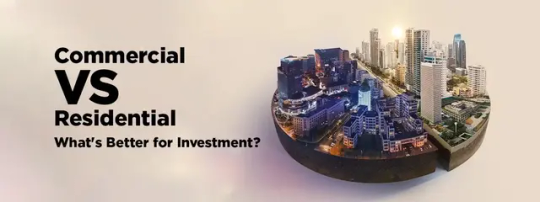
Gurgaon, one of India’s fastest-growing real estate hubs, has emerged as a prime location for investors looking to capitalize on property appreciation and rental yields. With its booming commercial sector and growing residential demand, choosing between commercial and residential property investments in Gurgaon can be challenging. In this blog, we will compare both investment options based on critical factors such as returns, risks, market trends, and growth potential.
1. Understanding Commercial And Residential Real Estate
What Is Commercial Real Estate?
Commercial properties include office spaces, retail shops, co-working spaces, and industrial buildings. These properties are primarily used for business purposes and generate income through lease or rental agreements.
What Is Residential Real Estate?
Residential properties consist of apartments, independent houses, and villas designed for individuals and families. These properties generate rental income and serve as long-term investments for capital appreciation.
2. Market Trends In Gurgaon (2025)
Gurgaon has witnessed rapid urbanization, infrastructure development, and the expansion of corporate offices. This growth has influenced both commercial and residential sectors, making it a hotspot for real estate investments.
Also Read Blog - 10 Benefits Of Real Estate Investment For Women - 2025
Key Trends In Commercial Real Estate
Increased demand for Grade A office spaces due to IT and corporate sector growth.
Rise in co-working spaces and flexible office setups.
High demand for retail spaces in malls and high-street locations.
Growing trend of mixed-use developments combining office and retail spaces.
Key Trends In Residential Real Estate
Rising demand for luxury apartments and gated communities.
Increase in rental demand due to corporate professionals relocating to Gurgaon.
Government initiatives promoting affordable housing projects.
Preference for sustainable and smart homes with modern amenities.
3. Investment Returns - Commercial Vs Residential Property
Rental Yields
Commercial Property - Higher rental yields, typically ranging from 6-10% per annum.
Residential Property - Lower rental yields, usually between 2-4% per annum.
Capital Appreciation
Commercial Property - High appreciation potential in prime business locations.
Residential Property - Moderate appreciation, but stable over the long term.
4. Risk Factors And Investment Stability
Risk in Commercial Property Investment
Requires higher initial investment and maintenance costs.
Market fluctuations impact occupancy rates.
Longer lease agreements provide stability but can be difficult to renegotiate.
Also Read Blog - Book Luxury 3 BHK Apartments At Lodha Opulis Mumbai
Risk in Residential Property Investment
Rental income is lower and may not cover mortgage payments.
Tenant turnover is higher, leading to frequent vacancies.
Dependent on economic factors and buyer demand.
5. Legal And Regulatory Aspects
Commercial Property - Subject to zoning laws, GST, and corporate leasing agreements.
Residential Property - Easier legal processes, fewer regulatory complications.
RERA Compliance - Both sectors must comply with Real Estate (Regulation and Development) Act, ensuring transparency.
6. Best Locations For Investment in Gurgaon (2025)
Top Commercial Investment Areas
Cyber City
Golf Course Road
Sohna Road
Udyog Vihar
Sector 29 and MG Road
Top Residential Investment Areas
Golf Course Extension Road
Dwarka Expressway
Sector 57, 58, 59 (Luxury Homes)
New Gurgaon (Affordable Housing)
7. Investment Costs And Affordability
Commercial Property Costs
Higher upfront investment.
Additional expenses such as maintenance and property management.
Higher loan eligibility due to stable income generation.
Residential Property Costs
More affordable investment options.
Lower maintenance costs.
Easy home loan approvals with lower interest rates.
Also Read Blog - ATS Province D Olympia Yamuna Expressway | Premium Plots for Sale
8. Future Growth Potential In Gurgaon
Growth Prospects For Commercial Property
Expansion of IT and corporate sectors is boosting demand for office spaces.
Increasing the retail market with higher consumer spending.
Development of new business districts enhancing commercial viability.
Growth Prospects For Residential Property
Rising population and migration to Gurgaon are driving housing demand.
Infrastructure projects like metro expansions improve connectivity.
Smart city initiatives are making Gurgaon a top residential choice.
9. Which Is Better - Commercial Or Residential Investment?
Choose Commercial Property
You seek higher rental yields and long-term stability.
You can invest a larger capital upfront.
You prefer corporate tenants and long lease durations.
Choose Residential Property
You want a lower-risk investment with steady appreciation.
You prefer easily manageable properties.
You are looking for a place for self-use or rental income.
10. Expert Tips For Smart Investment Decisions
Assess Market Demand - Understand the demand for office spaces or residential properties in your chosen location.
Financial Planning - Evaluate your budget, financing options, and expected ROI before investing.
Legal Due Diligence - Ensure the property complies with all legal and regulatory requirements.
Professional Assistance - Consult with real estate experts to make informed decisions.
Diversify Portfolio - Consider a mix of commercial and residential properties for balanced investment.
Finish Line - Making the Right Investment Choice
Both commercial and residential properties in Gurgaon offer unique advantages. Commercial properties provide higher rental yields and growth potential, while residential properties ensure stability and long-term capital appreciation. Investors should assess their financial goals, risk appetite, and market conditions before making a decision.
With Gurgaon’s dynamic real estate market, strategic investment planning and expert guidance can help maximize returns in both sectors. If you opt for commercial or residential real estate, Gurgaon remains a promising investment destination in 2025.
#Best property investment in Gurgaon 2025#Gurgaon real estate market trends#Commercial property investment in Gurgaon#Residential property investment in Gurgaon#Best locations to buy property in Gurgaon#Gurgaon property investment guide#Future of real estate in Gurgaon#Office space investment in Gurgaon#Luxury apartments in Gurgaon#Best commercial areas in Gurgaon#Commercial property appreciation in Gurgaon#Office spaces for sale in Gurgaon#Retail shops investment in Gurgaon#High rental yield commercial properties Gurgaon#Co-working spaces investment in Gurgaon#Cyber City Gurgaon property investment#Golf Course Road commercial properties#Sohna Road commercial investment#Udyog Vihar property rates#Best residential areas in Gurgaon#Affordable housing projects in Gurgaon#Luxury residential projects in Gurgaon#Ready-to-move flats in Gurgaon#Gated communities in Gurgaon#Sector-wise property prices in Gurgaon#Best builder floors in Gurgaon#Rental demand in Gurgaon residential areas#New residential projects in Gurgaon#Home loan options for Gurgaon properties#Best ROI property investment in Gurgaon
0 notes
Text
Karen Simon: The Trailblazing Journey of Breaking Barriers to Building Empires
Karen Simon, President and Managing Partner of Emersons Commercial Real Estate, graced the cover of World’s Leaders Magazine as one of the Worlds Most Influential Women Redefining Success in 2025

0 notes
Text
Comprehensive loan services by loan experts India: Your reliable financial partner Loan expert

India is a major financial services provider who is committed to help individuals and businesses access to the best loan options to suit their needs. With a team of experienced professionals, they provide expert guidance, competitive interest rates and hassle -free loan approval. Loan Experts India services cover a wide range of financial requirements including home loans, personal loans, business loans, and more.
Types of loan services by loan experts India
1. Retail loan
Retail loans are individual or consumer loans provided to individuals for various financial requirements, such as home procurement, vehicle financing, education or personal expenses. These loan come with flexible repayment options and competitive interest rates.
Types of retail loan include:
1 Personal loan - unsafe loan for personal expenses such as travel, medical emergency or marriage costs.
Home Loan - Financial assistance for buying or construction of a house with long -term repayment tenure.
Car loan - Loans to buy new or used vehicles with low EMI and minimal documentation.
Education Loans - In India, abroad with funds or repayment flexibility for higher education in India. Retail loans are ideal for salaried individuals, self-employed professionals and pensioners in search of financial assistance for individual needs.
2. Msme trade loan Micro, small and medium enterprises (MSME)
These loans can be used for business expansion, machinery procurement, working capital or inventory stocking. Many MSME loans are supported by government encouragement, making them a cost -effective financing solution.
Major features of MSME loan:
• Quick dysbersal to get businesses timely financial assistance.
• Flexible repayment tenure from 1 to 10 years.
• Depending on business needs, loan amount from 50,000 to ₹ 10 crore.
• Collateral-free option under government schemes such as CGTMSE (Credit Guarantee Fund for Micro and Small Enterprises).
loans are financial solutions designed to support small business owners, startups and entrepreneurs in the expansion of their businesses.
3. Government loan schemes
Government loan schemes provide financial assistance to individuals, businesses and startups under various initiatives by the Government of India. The objective of these schemes is to promote entrepreneurship, housing, education and rural development.
Popular government loan schemes include:
• Pradhan Mantra Mudra Yojana (PMMY) - Mut provides currency loan up to 10 lakhs for small businesses.
• Pradhan Mantri Awas Yojana (PMAY) - Home loan subsidy for affordable housing.
• stand-up India scheme-Loans for women and SC/ST entrepreneurs to start business.
• Startup India Scheme - Financial Assistance for Startup with Tax Benefits and Easy Funding Access.
Government loan schemes provide low interest rate, subsidy and comfortable eligibility criteria, making them accessible to a large population.
4 Bank auction properties
Bank auction properties refer to real estate assets by banks due to loan omission. These properties are auctioned at concessional prices, which offers buyers an opportunity to invest in real estate at minimum-and-market rates.
Major benefits of buying bank auction properties:
Prices lower than market value, making it a cost -effective investment.
Properties available in major places including residential, commercial and industrial property.
Transparent procurement process with bank participation, reducing the risks of fraud.
Funding options available through home loans, making property acquisition easier.
Buyers should conduct proper hard work, legal verification and financial planning before purchasing auctioned properties to avoid legal complications.
Benefits of Choosing Loan Experts India India
Specialist counseling: Get guidance from industry professionals who understand the complications of loan processes. Our experts provide analogous advice, helping to navigate financial options and choose the best solution based on their needs.
Nationalized bank participation: We collaborate with major nationalized banks to provide you safe, reliable and competitive loan options. Our strong participation ensures better interest rates, transparent processes and rapid approval.
End-to-end support: For loan disbursement and post-lone assistance from initial consultation, we provide full support at every stage. Our team handles documentation, talks and followers to make the entire process smooth and trouble free.
Customized loan solution: Every financial requirement is unique, and therefore our loan solutions. We assess your specific requirements and tailor loan schemes that are best suited for your financial goals, repayment capacity and future growth prospects
Tips for a Successful Loan Approval
Maintaining a Good Credit Score
A strong credit score is important to obtain loans with favorable conditions. Regularly paying bills, keeping credit use low, and avoiding many loan applications can help maintain a healthy credit score, which increases the chances of your loan approval.
Choosing the Right Loan Amount and Tenure
Selecting the appropriate loan amount and ensures the repayment tenure financial stability. Borrowing within your repayment capacity and selecting for a suitable tenure helps to balance EMI, reducing financial stress, reducing interest costs.
Understanding the Terms and Conditions
Before taking the loan, carefully review the terms and conditions including interest rates, processing fees, pre -payment fees and punishment. Understanding these details helps to avoid hidden costs and ensures a smooth borrowing experience.
1 note
·
View note
Text
FIRST ONSITE Manager Launches CREW Ottawa to Support Women in Commercial Real Estate
Voir français ci-dessous National Capital Region now has a dedicated space for women in commercial real estate LEFT TO RIGHT – CREW NETWORK PRESIDENT CINDY MACMILLAN (CREW VANCOUVER) WELCOMES CREW OTTAWA PRESIDENT SARAH CROUCH (FIRST ONSITE MANAGER OF BUSINESS DEVELOPMENT) MISSISSAUGA, ON, MARCH 5, 2025/insPRESS/ – First Onsite Property Restoration announced today that it celebrates Sarah…
0 notes
Text
Educational Resources and Certifications for Aspiring Commercial Loan Brokers!
Introduction:
Entering the commercial loan market requires specialized knowledge and expertise beyond traditional residential mortgage lending. Aspiring commercial loan brokers, particularly residential mortgage officers looking to transition into commercial lending, can benefit from targeted educational resources and certifications to enhance their skills and credibility in the industry. In this article, we explore recommended courses, certifications, and resources for aspiring commercial loan brokers, providing valuable guidance for professional development and career advancement. 1. Commercial Loan Broker Training Programs:
Enrolling in commercial loan broker training programs can provide aspiring brokers with comprehensive education and practical skills to succeed in the industry. These programs often cover topics such as commercial lending fundamentals, underwriting principles, loan structuring, risk assessment, and regulatory compliance. Look for reputable training providers that offer interactive learning experiences and real-world case studies to enhance your knowledge and application skills. 2. Professional Certifications:
Obtaining professional certifications can demonstrate your expertise and commitment to excellence in commercial loan brokering. Consider pursuing certifications such as:
Certified Commercial Loan Officer (CCLO)
Certified Commercial Mortgage Broker (CCMB)
Commercial Real Estate Finance (CREF) Certification
These certifications typically require passing rigorous exams and meeting continuing education requirements to maintain professional competency. 3. Industry Associations and Networking Events:
Joining industry associations and attending networking events can provide valuable opportunities for learning, professional development, and networking with industry peers. Organizations such as the Mortgage Bankers Association (MBA), National Association of Commercial Loan Brokers (NACLB), and Commercial Real Estate Women (CREW) offer educational resources, networking opportunities, and industry insights for aspiring commercial loan brokers. 4. Online Courses and Webinars:
Online courses and webinars offer flexible and convenient learning options for busy professionals seeking to expand their knowledge and skills in commercial lending. Look for courses offered by reputable educational institutions, industry associations, and professional training providers. Topics may include commercial loan underwriting, financial analysis, risk management, and regulatory compliance. 5. Books and Publications:
Reading books and publications on commercial lending can provide valuable insights and practical tips for aspiring brokers. Look for authoritative resources written by industry experts and practitioners. Topics may cover various aspects of commercial lending, including loan origination, negotiation strategies, market analysis, and industry trends. 6. Mentorship and Internship Opportunities:
Seeking mentorship and internship opportunities can provide hands-on experience and guidance from seasoned professionals in the industry. Connect with experienced commercial loan brokers or industry mentors who can offer valuable advice, share best practices, and provide insights into the day-to-day realities of the business.
Conclusion:
Investing in education, certifications, and professional development is essential for aspiring commercial loan brokers to build credibility, expand their knowledge base, and succeed in the competitive industry landscape. By taking advantage of educational resources, certifications, industry associations, networking events, online courses, mentorship opportunities, and relevant publications, aspiring brokers can position themselves for success and unlock rewarding career opportunities in commercial loan brokering.

#CommercialLoanBroker#MortgageBroker#LoanBrokerTraining#FinanceEducation#CommercialLending#RealEstateFinance#LoanOfficer#BusinessLoans#BrokerCertification#FinancialEducation#Networking#Mentorship#LoanUnderwriting#FinanceCareer#ProfessionalDevelopment
1 note
·
View note
Text
Kiansh Properties: The Best Property Dealer in New Delhi
When it comes to finding the perfect property in New Delhi, whether for residential or commercial purposes, Kiansh Properties stands out as a trusted name. Located conveniently near Shiv Mandir, Patel Nagar, New Delhi, Kiansh Properties has built a solid reputation for helping clients find their ideal spaces with ease and professionalism.
Why Choose Kiansh Properties?
Kiansh Properties is known for its deep understanding of the real estate market, offering personalized services tailored to the unique needs of each client. Their team of experienced professionals ensures that every deal is transparent, fair, and beneficial.
Key highlights of their services include:
Wide Range of Properties: From modern office spaces to cozy residential homes, Kiansh Properties offers a variety of options.
Client-Centric Approach: They prioritize customer satisfaction, guiding clients through every step of the buying, selling, or renting process.
Prime Location Expertise: Specializing in properties around Patel Nagar and nearby areas.
Stamp Duty & Registration Charges for Properties in Patel Nagar
When buying a property in Patel Nagar, it’s important to understand the additional costs involved — particularly stamp duty and registration charges. These fees are mandatory for legally registering the property in your name. Let’s break them down clearly:
What is Stamp Duty?
Stamp duty is a tax imposed by the government on property transactions.
It serves as legal proof of property ownership.
What are Registration Charges?
Registration charges are the fees paid to the government for registering the sale deed or property document.
This process officially records you as the property’s legal owner.
Current Rates in Patel Nagar, New Delhi The stamp duty and registration charges typically follow these rates:
Stamp Duty:
6% for male property owners
4% for female property owners (to encourage women's property ownership)
Registration Charges: 1% of the property value
How to Calculate Stamp Duty & Registration Fees Let’s say you are purchasing a property worth ₹50 lakhs in Patel Nagar:
For Male Buyer:
Stamp Duty: 6% of ₹50,00,000 = ₹3,00,000
Registration Charges: 1% of ₹50,00,000 = ₹50,000
Total Cost: ₹3,50,000
For Female Buyer:
Stamp Duty: 4% of ₹50,00,000 = ₹2,00,000
Registration Charges: 1% of ₹50,00,000 = ₹50,000
Total Cost: ₹2,50,000
How to Pay Stamp Duty & Registration Charges
Payments can be made online through the official Delhi government portal.
Alternatively, you can visit the Sub-Registrar’s Office in Patel Nagar for offline payments.
Let Kiansh Properties Guide You
Understanding stamp duty and registration charges can be tricky, but Kiansh Properties is here to simplify the process. As the best property dealer in Patel Nagar, they not only help you find the right property but also guide you through all legal and financial formalities.
📍 Location: Shiv Mandir, Patel Nagar, New Delhi 📞 Contact: +91 95820 87044 📧 Email: [email protected]
Make your property-buying journey smooth and stress-free — with Kiansh Properties by your side!
#property#real estate#realestate#properties for rent#property dealer#property investment#real estate india#real estate investing
0 notes